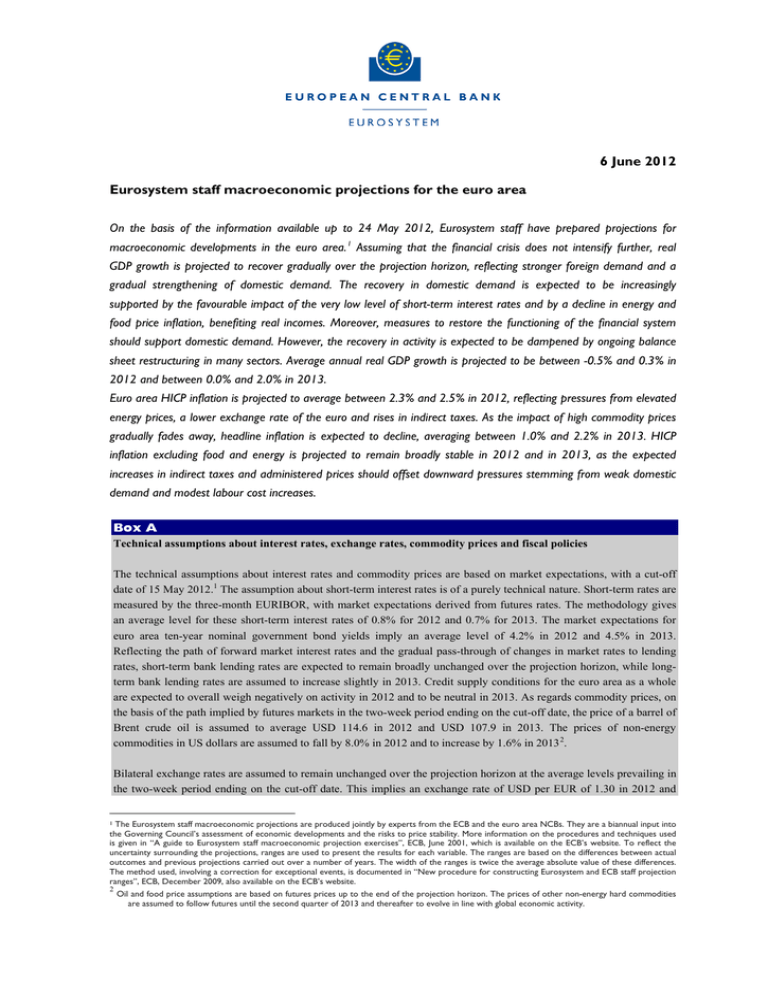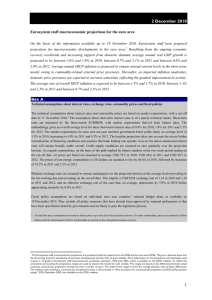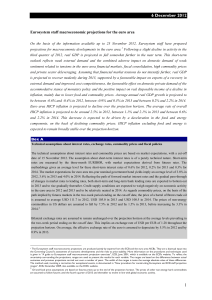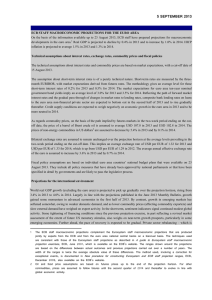6 June 2012 Eurosystem staff macroeconomic projections for the euro area
advertisement

6 June 2012 Eurosystem staff macroeconomic projections for the euro area On the basis of the information available up to 24 May 2012, Eurosystem staff have prepared projections for macroeconomic developments in the euro area. 1 Assuming that the financial crisis does not intensify further, real GDP growth is projected to recover gradually over the projection horizon, reflecting stronger foreign demand and a gradual strengthening of domestic demand. The recovery in domestic demand is expected to be increasingly supported by the favourable impact of the very low level of short-term interest rates and by a decline in energy and food price inflation, benefiting real incomes. Moreover, measures to restore the functioning of the financial system should support domestic demand. However, the recovery in activity is expected to be dampened by ongoing balance sheet restructuring in many sectors. Average annual real GDP growth is projected to be between -0.5% and 0.3% in 2012 and between 0.0% and 2.0% in 2013. Euro area HICP inflation is projected to average between 2.3% and 2.5% in 2012, reflecting pressures from elevated energy prices, a lower exchange rate of the euro and rises in indirect taxes. As the impact of high commodity prices gradually fades away, headline inflation is expected to decline, averaging between 1.0% and 2.2% in 2013. HICP inflation excluding food and energy is projected to remain broadly stable in 2012 and in 2013, as the expected increases in indirect taxes and administered prices should offset downward pressures stemming from weak domestic demand and modest labour cost increases. Box A Technical assumptions about interest rates, exchange rates, commodity prices and fiscal policies The technical assumptions about interest rates and commodity prices are based on market expectations, with a cut-off date of 15 May 2012.1 The assumption about short-term interest rates is of a purely technical nature. Short-term rates are measured by the three-month EURIBOR, with market expectations derived from futures rates. The methodology gives an average level for these short-term interest rates of 0.8% for 2012 and 0.7% for 2013. The market expectations for euro area ten-year nominal government bond yields imply an average level of 4.2% in 2012 and 4.5% in 2013. Reflecting the path of forward market interest rates and the gradual pass-through of changes in market rates to lending rates, short-term bank lending rates are expected to remain broadly unchanged over the projection horizon, while longterm bank lending rates are assumed to increase slightly in 2013. Credit supply conditions for the euro area as a whole are expected to overall weigh negatively on activity in 2012 and to be neutral in 2013. As regards commodity prices, on the basis of the path implied by futures markets in the two-week period ending on the cut-off date, the price of a barrel of Brent crude oil is assumed to average USD 114.6 in 2012 and USD 107.9 in 2013. The prices of non-energy commodities in US dollars are assumed to fall by 8.0% in 2012 and to increase by 1.6% in 2013 2. Bilateral exchange rates are assumed to remain unchanged over the projection horizon at the average levels prevailing in the two-week period ending on the cut-off date. This implies an exchange rate of USD per EUR of 1.30 in 2012 and 1 The Eurosystem staff macroeconomic projections are produced jointly by experts from the ECB and the euro area NCBs. They are a biannual input into the Governing Council’s assessment of economic developments and the risks to price stability. More information on the procedures and techniques used is given in “A guide to Eurosystem staff macroeconomic projection exercises”, ECB, June 2001, which is available on the ECB’s website. To reflect the uncertainty surrounding the projections, ranges are used to present the results for each variable. The ranges are based on the differences between actual outcomes and previous projections carried out over a number of years. The width of the ranges is twice the average absolute value of these differences. The method used, involving a correction for exceptional events, is documented in “New procedure for constructing Eurosystem and ECB staff projection ranges”, ECB, December 2009, also available on the ECB’s website. 2 Oil and food price assumptions are based on futures prices up to the end of the projection horizon. The prices of other non-energy hard commodities are assumed to follow futures until the second quarter of 2013 and thereafter to evolve in line with global economic activity. 2013. On average, the effective exchange rate of the euro is assumed to depreciate by 4.4% in 2012 and by 0.3% in 2013. Fiscal policy assumptions are based on individual euro area countries’ national budget plans that were available on 24 May 2012. They include all policy measures that have already been approved by national parliaments or that have been specified in detail by governments and are likely to pass the legislative process. The international environment A gradual acceleration in world economic activity over the projection horizon is expected to be supported by improving financial conditions in an environment of accommodative monetary policies. In addition, reconstruction and the easing of supply chain disruptions following the natural disasters in Japan and Thailand should also provide some impetus to global activity in 2012. Over the medium term, the pace of growth in the external environment of the euro area is expected to be dampened by considerable weakness in the labour and housing markets, as well as by the need to further repair both public and private sector balance sheets. In emerging markets, growth has moderated recently but remains solid, thereby making an important contribution to global economic growth. World real GDP growth outside the euro area is projected to fall from 4.1% in 2011 to 3.8% in 2012, before picking up to 4.3% in 2013. Euro area foreign demand is estimated to grow by 4.0% in 2012 and by 6.4% in 2013. Real GDP growth projections Euro area real GDP stagnated in the first quarter of 2012, having declined by 0.3% in the fourth quarter of 2011. Real GDP growth is expected to weaken in the second quarter of this year. The fragility of activity seen lately is due primarily to weak domestic demand, reflecting the combined adverse effect of the euro area sovereign debt crisis on consumer and business confidence, high oil prices, adverse credit supply conditions and a tightening in the fiscal stance in some euro area countries. Looking ahead, assuming that the financial crisis does not intensify further, real GDP growth is projected to pick up over the projection horizon. The recovery reflects the acceleration of growth in global trade, and therefore in foreign demand, as well as a gradual strengthening of domestic demand. For its part, domestic demand is expected to be supported by the very low level of short-term interest rates and by the favourable impact of a decline in energy and food price inflation on households’ real disposable income. Moreover, measures to restore the functioning of the financial system should support domestic demand. Overall, the recovery is likely to be rather muted by historical standards owing to the ongoing need for public and private sector balance sheet restructuring in several euro area countries. In annual terms, euro area real GDP is expected to grow by between -0.5% and 0.3% in 2012 and between 0.0% and 2.0% in 2013. In more detail, extra-euro area export growth is projected to gain momentum over the projection horizon, mainly reflecting the strengthening of foreign demand and the effects of past gains in export price competitiveness. Euro area export market shares, which have been recovering of late, are projected to stabilise over the projection horizon. 2 Euro area non-residential private investment is expected to further decline in the near term, before recovering over the projection horizon, supported by the strengthening of demand, low interest rates and improving profit mark-ups. Residential investment is expected to recover only marginally over the projection horizon. Ongoing adjustments in the housing markets in some countries continue to dampen the recovery in residential investment. However, these adverse developments are partly offset by the enhanced attractiveness of housing investment, relative to other forms of investment, in some other countries, where residential investment should also be fuelled by low mortgage rates. Government investment is expected to decline throughout the projection horizon, as indicated in the fiscal consolidation packages in several euro area countries. Private consumption is projected to remain subdued throughout 2012, as a large fall in real disposable income is only partly compensated by a decline in the saving ratio, reflecting inter-temporal consumption smoothing. The large decline in real disposable income is due to a decrease in both employment and real compensation per employee, fiscal consolidation measures and weak non-labour income. In 2013, private consumption is expected to increase moderately, mainly reflecting a recovery in real disposable income as the adverse impact of the aforementioned factors gradually fades, while it should also be supported by a decline in commodity price pressures. Government consumption in real terms is projected to remain broadly stable in both 2012 and 2013. The pace of extra-euro area import growth is expected to gain momentum over the projection horizon, albeit still constrained by weak domestic demand. Reflecting stronger growth in exports, net trade is expected to make a significant positive contribution to real GDP growth over the whole projection horizon. Table 1 Macroeconomic projections for the euro area (average annual percentage changes)1) 2011 2012 2013 HICP 2.7 2.3 – 2.5 1.0 – 2.2 Real GDP 1.5 -0.5 – 0.3 0.0 – 2.0 Private consumption 0.2 -0.7 – -0.1 -0.4 – 1.4 Government consumption -0.3 -0.7 – 0.3 -0.7 – 0.7 Gross fixed capital formation 1.6 -3.2 – -1.0 -0.8 – 3.8 Exports (goods and services) 6.3 1.2 – 5.0 1.1 – 8.9 Imports (goods and services) 4.1 -0.7 – 2.9 0.9 – 7.9 1) The projections for real GDP and its components refer to working day-adjusted data. The projections for imports and exports include intra-euro area trade. The ongoing crisis is expected to have adversely affected potential growth, although the exact magnitude of the impact remains highly uncertain. It is likely that the continued weakness in employment and investment 3 will further weigh on potential output growth. Given the weak outlook for growth, the negative output gap is projected to widen in 2012 before narrowing somewhat in 2013. Price and cost projections HICP inflation is expected to average between 2.3% and 2.5% in 2012. This relatively elevated level reflects the effects of the hikes in oil prices, the impact of a weakened exchange rate of the euro and increases in indirect taxes. Inflation is expected to ease considerably, averaging between 1.0% and 2.2% in 2013. This deceleration in inflation will be driven largely by the projected developments in the energy component. As crude oil prices are assumed to decline gradually over the projection horizon and the impact of past increases fades away, the contribution from energy prices to the headline inflation rate is expected to decline in 2013. The contribution from the food component is also expected to decline, albeit by much less. HICP inflation excluding food and energy is projected to remain broadly stable in 2012 and 2013 as the expected increases in indirect taxes and administered prices exert upward pressures on inflation, offsetting the downward pressures stemming from weak domestic demand and moderate labour cost increases. In more detail, external price pressures increased at the turn of the year, driven by rising oil prices and a weaker exchange rate of the euro. However, the technical assumptions about exchange rates and commodity prices imply that these external pressures should ease over the projection horizon. In addition, the annual growth rate of the import deflator will be subject to large downward base effects as the increases of the past year drop out of annual comparisons. Its annual growth rate is therefore expected to decline sharply over the projection horizon. Turning to domestic price pressures, the annual growth rate in compensation per employee is projected to decrease slightly in 2012 and somewhat further in 2013, on the back of deteriorating labour market conditions. Given the elevated average inflation rate in 2012, real compensation per employee is expected to decline. It is expected to pick up in 2013, reflecting the projected decline in the inflation rate, but to grow more slowly than productivity over the entire projection horizon. The annual growth rate of unit labour costs is expected to bounce back in 2012, mirroring the cyclical weakness in productivity growth. Thereafter, it is expected to moderate in 2013, as productivity picks up and wage pressures remain contained. Profit margins are expected to decline in 2012, cushioning the sharp rise in unit labour costs, against the backdrop of subdued aggregate demand. A rebound in profit margins is projected for 2013, on the back of weaker growth in unit labour costs, owing to stronger growth in productivity and a recovery in demand. Reflecting the ongoing fiscal consolidation in many euro area countries, increases in administered prices and indirect taxes are expected to make an above-average contribution to HICP inflation both in 2012 and in 2013. Comparison with the March 2012 projections Compared with the ECB staff macroeconomic projections published in the March 2012 issue of the Monthly Bulletin, the range of the real GDP growth projection for 2012 remains unchanged, while there is a slight narrowing of the range for 2013. With regard to HICP inflation, there is a narrowing of the projection ranges for both 2012 and 2013. 4 Table 2 Comparison with the March 2012 projections (average annual percentage changes) 2012 2013 Real GDP – March 2012 -0.5 – 0.3 0.0 – 2.2 Real GDP – June 2012 -0.5 – 0.3 0.0 – 2.0 HICP – March 2012 2.1 – 2.7 0.9 – 2.3 HICP – June 2012 2.3 – 2.5 1.0 – 2.2 Box B Forecasts by other institutions A number of forecasts for the euro area are available from both international organisations and private sector institutions. However, these forecasts are not strictly comparable with one another or with the Eurosystem staff macroeconomic projections, as they were finalised at different points in time. Additionally, they use different (partly unspecified) methods to derive assumptions for fiscal, financial and external variables, including oil and other commodity prices. Finally, there are differences in working day adjustment methods across different forecasts (see the table below). In the forecasts currently available from other institutions, euro area real GDP is expected to decline by between 0.1% and 0.4% in 2012, which is within the range of the Eurosystem staff projections. In 2013, real GDP is projected to increase by between 0.8% and 1.0%, which is also within the range of the Eurosystem staff projections. As regards inflation, the forecasts from other institutions point to an average annual HICP inflation of between 2.0% and 2.4% in 2012, which is within or somewhat below the range of the Eurosystem staff projections. In 2013, HICP inflation is expected to average between 1.6% and 1.9%, which is within the Eurosystem staff projection ranges. Comparison of forecasts for euro area real GDP growth and HICP inflation (average annual percentage changes) Date of release GDP growth HICP inflation 2012 2013 2012 2013 IMF Survey of Professional Forecasters April 2012 May 2012 -0.3 -0.2 0.9 1.0 2.0 2.3 1.6 1.8 Consensus Economics Forecasts May 2012 -0.4 0.8 2.4 1.8 OECD May 2012 -0.1 0.9 2.4 1.9 European Commission May 2012 -0.3 1.0 2.4 1.8 Eurosystem staff projections June 2012 -0.5 – 0.3 0.0 – 2.0 2.3 – 2.5 1.0 – 2.2 Sources: European Commission Economic Forecasts, Spring 2012; IMF World Economic Outlook, April 2012; OECD Economic Outlook, May 2012; Consensus Economics Forecasts; and the ECB’s Survey of Professional Forecasters. Notes: The Eurosystem staff macroeconomic projections and the OECD forecasts both report working day-adjusted annual growth rates, whereas the European Commission and the IMF report annual growth rates that are not adjusted for the number of working days per annum. Other forecasts do not specify whether they report working day-adjusted or nonworking day-adjusted data. 5



